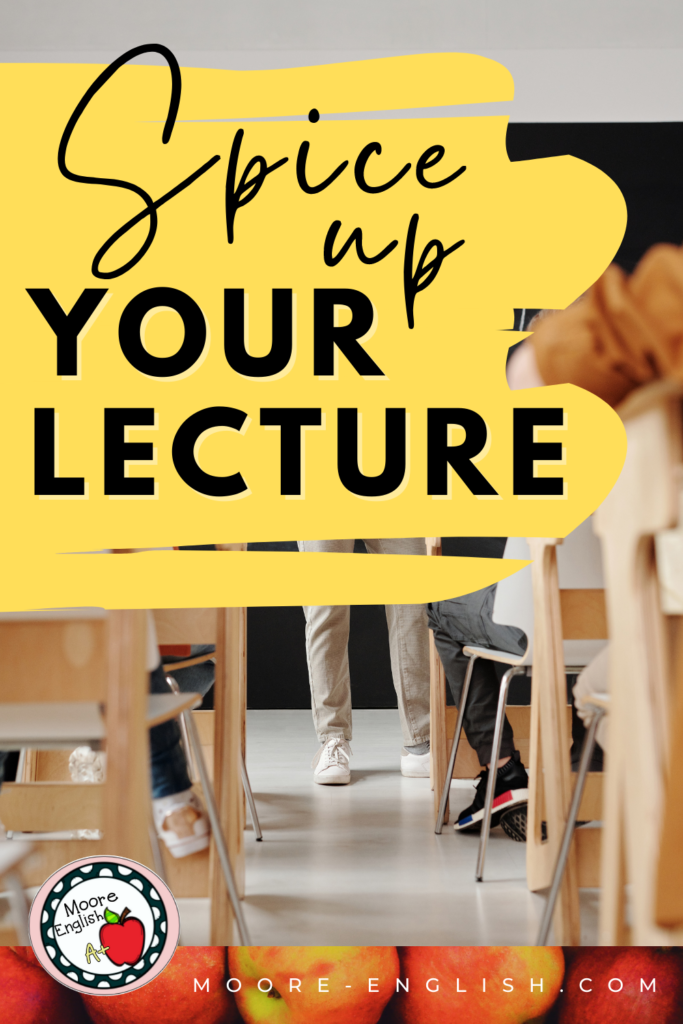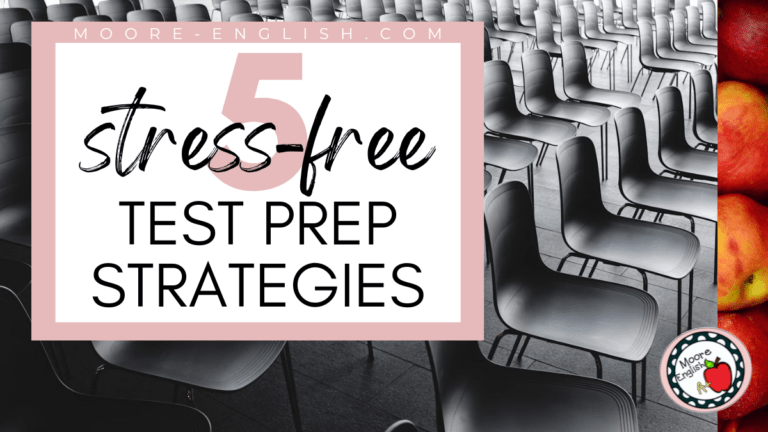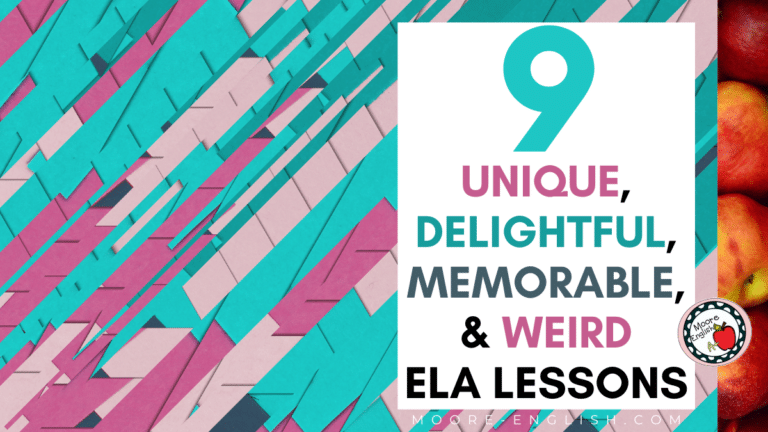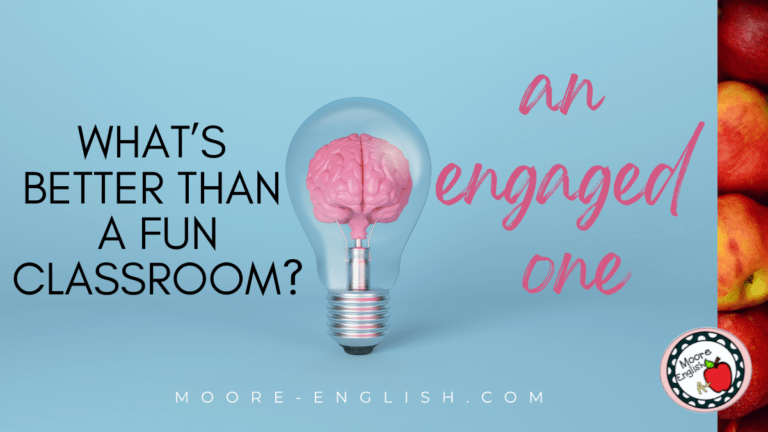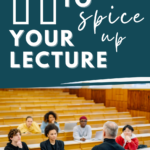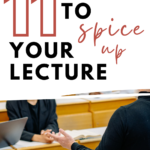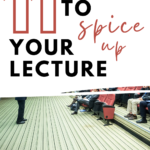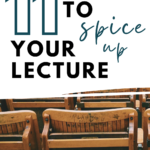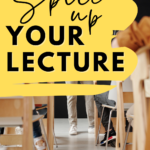I recently started working on my doctorate. The program began with an on-campus orientation. While I enjoyed meeting my professors and the rest of my cohort, the actual orientation was dull. In part, I’m excited about this program because I like school. Some people have a knack for learning languages or composing music, but I am good at school. I enjoy learning. I sometimes even enjoy a good lecture.
However, it struck me (and not for the first time) that in a class where we were discussing the importance of student engagement, the professor lectured. They did not make any of the “moves” you might expect to see from a teacher cultivating student engagement.
On my way home from orientation, I made a mental list of quick, low-stress activities that would make any lecture more engaging. Today, I want to share those strategies with you.
This post this post may contain affiliate links. Please read the Terms of Use.
Choosing Your Instructional Method
A lot of lecture comes in courses where teachers feel a need to cover a broad range of content, perhaps in a short period of time. As an ELA teacher, I focus more on skill development than on content knowledge, so perhaps I feel this pressure differently than teachers in other contents. While there are times when lecture is the instructional method of choice, here are some alternatives.
First, inquiry-based learning is a great way to teach specific content, especially vocabulary. I use this strategy to teach domain-specific vocabulary like aphorism and parallelism. In both situations, I give students examples and then challenge them to work in small groups to develop their own definition and examples. Inquiry-based learning is a great way to increase student engagement and help students make connections with the content. In this post, I explain my complete lesson plan for using inquiry-based learning with Shakespearean sonnets.
Second, students are more likely to remember what they teach. Strategies where students lead the lesson can be a great alternative to a lecture. There are a thousand different ways to set this up, but here are some tools to help:
- Give each student or small group a topic or concept to research. Ask students to present their research in a Google Slides.
- Similarly, task each student or small group with developing an active lesson where they use technology like Google Jamboard to engage their classmates.
- Provide students with an excerpt from the reading, and ask students to lead their classmates through close reading the passage. Students can practice thinking aloud and questioning the text and their peers. I most-recently did this with “Sinners in the Hands of an Angry God.”
Finally, guided reading is my go-to strategy when we’re looking at a more complex concept or process and/or when I’m introducing a new reading. Guided reading is a great strategy because it’s flexible. Each time I use guided reading in the classroom, I’m looking for moments to gradually release students. This is perfect for cycles of gradual release.
Incorporating Discussion into Lecture
With any of the strategies listed above, teachers have a chance to incorporate classroom discussion. Lecture can always be the basis for a classroom discussion, especially since lecture often happens at a lower depth of knowledge while discussion usually involves a higher depth of knowledge.
First, think-pair-share is a tried-and-true instructional strategy for a reason. When we’re reading and annotating a text as a whole group, this is often the strategy I use to help students think through their initial annotations. As students share their annotations with a neighbor, they shift through the questions and comments they want to explore as a whole group.
Second, a listening lecture is one where students listen to the lecture, perhaps taking notes or making annotations. However, by the time the lecture ends, students are required to generate 1-3 meaningful discussion questions to share with their classmates. A variation of this strategy is to give students discussion questions ahead of time and to have them listen for related information in the lecture.
Finally, a Socratic Seminar is the most formal way to involve discussion in a lecture. After a lecture, ask students to formulate their thoughts into a series of positions or questions. Establish clear rules for engaging in meaningful conversation, and then invite students to discuss.
With both the listening lecture and the Socratic Seminar, it helps if students have been consistently building community and establishing expectations for respectful discussions. In both cases, I find it most helpful to have students move their seats to sit in a circle where the teacher is either part of or beyond the circle, so she is not leading the discussion.
Add Movement!
Lecture can sometimes be challenging because it asks students to sit in one place for a long time. Instead of a traditional lecture, here are some options that incorporate movement and might be more engaging for students.
First, if lecture has been chosen because it’s a good way to cover a lot of content, stations can be a good alternative. At the most basic level, teachers can copy their lecture notes or slides and students can move from station to station creating their own notes or annotations. In a more elaborate station model, teachers can divide stations based on concepts or based on DOK levels. Stations can even be fully digital if necessary! When I do stations, I like to have one teacher-led station where I can check in with students and/or lead intervention. Check out my favorite stations for literary analysis!
Secondly, Gallery Walks can be a good strategy for encouraging student movement. At each “stop” on the Gallery Walk, students can read or watch part of the lecture. Then, using chart paper, students can leave comments, questions, or connections about the content. At the end of the Gallery Walk, students will still have the same notes they would have developed by the end of the lecture.
Finally, task cards can be a great way to elevate lecture. After a lecture, teachers can ask students to complete task cards as a way of applying or demonstrating their knowledge. This can become valuable formative data that teachers can use to adjust the following day’s lesson plan. To make this even more engaging, teachers can give students the task cards at the start of the lecture so students know exactly what they should listen for. Grab my best task cards today!
Write About It
Writing is a fantastic way for students to demonstrate their thinking. Incorporating writing before, during, and after a lecture can make the lecture more engaging. This is also a great way to help students see their thinking progress.
First, graphic organizers are the most low-threat kind of writing. With a graphic organizer like a KWL chart, students can track their thinking throughout a lecture. With more advanced graphic organizers, students can make predictions, take notes, and reflect on a lesson throughout. My scaffolded notes pages are free and are a great way to engage students in a lecture.
Second, journals can be as formal or informal as teachers would like. Oftentimes, opening a lecture with an essential question or journal prompt can help frame the lecture and help students understand why the lecture content is relevant. Midway through the lecture, ask students to adjust their initial thoughts. Then, follow the lecture with an after-reading reflection. This can become a great exit ticket for students! Check out my collection of journal prompts today!
Last Words on Lecture
At the end of the day, lecture is an instructional strategy that’s probably not going anywhere. However, with these 11 quick strategies, teachers can make each lecture a little more engaging! What are some ways you keep lectures from feeling stale?

